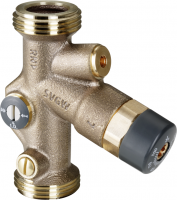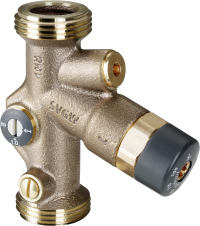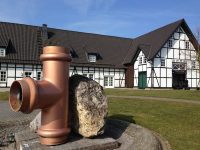Viega LLC’s new Automatic Recirculation Balancing Valve ensures a balanced domestic water recirculation system by dynamically changing with varying conditions. The Automatic Recirculation Balancing Valve is a modification of a Viega product that has been used successfully in Europe for years. It helps keep water temperatures more uniform by adjusting flow with changes in temperature Read more
Water Quality

 Viega LLC’s new Automatic Recirculation Balancing Valve ensures a balanced domestic water recirculation system by dynamically changing with varying conditions.
Viega LLC’s new Automatic Recirculation Balancing Valve ensures a balanced domestic water recirculation system by dynamically changing with varying conditions.
The Automatic Recirculation Balancing Valve is a modification of a Viega product that has been used successfully in Europe for years. It helps keep water temperatures more uniform by adjusting flow with changes in temperature. The results are faster hot water delivery, minimized waste energy and water and less stagnation and chance of contamination. Among the valve’s features:
- Unlike with manual valves, temperature can be set once and be maintained automatically.
- Settings can be changed easily, if needed.
- Can be installed on risers or branches
- Remote monitoring with temperature sensor
- Optional thermometer provides visual indication of valve setting
- Threaded ends allow it to be used with Viega ProPress or Viega PureFlow fittings systems
- Includes bypass for thermal disinfection
Additional accessories that can be used with the valve include a thermometer, drain valve and optional insulation sleeve.
“Viega is committed to providing hot water quickly and efficiently while improving water quality and the new Automatic Recirculation Balancing Valve is a significant step toward that goal,” said Paige Riddle, product manager, valves. “This valve offers more features than any other on the market while requiring minimum work on the part of designers, engineers, installers and building maintenance personnel.”
To learn more about Viega and its work to improve water quality, click here.

While factors such as efficiency, performance, and cost-savings are carefully scrutinized in the process of purchasing and installing water heating systems, the issue of local water quality seems largely overlooked by comparison despite its significance. The degree of attention that is given to water quality characteristics could be the difference between performance issues and premature Read more
While factors such as efficiency, performance, and cost-savings are carefully scrutinized in the process of purchasing and installing water heating systems, the issue of local water quality seems largely overlooked by comparison despite its significance. The degree of attention that is given to water quality characteristics could be the difference between performance issues and premature failure or increased longevity and reduced operating costs. Below are two things worth taking into consideration:
 Scale Build-up
Scale Build-up
All water, regardless of where you are, contains dissolved minerals such as calcium-carbonate, magnesium, silica, iron, phosphates and so on. The challenge, however, is when you’re in an area with higher concentrations of these substances. When water is heated, these dissolved minerals will precipitate out as solids. The minerals (specifically calcium and magnesium), form lime-scale which is a poor conductor of heat. This means that less heat is transferred into the water and more money is wasted out the exhaust. An increased build-up of scale over time will inhibit product performance and compromise the efficiency of your unit. Enough build-up over time, left untreated, can cause your unit to fail altogether.
Heightened Chloride Levels
Although chloride is a common substance that is typically harmless in low quantities, its impact on plumbing and water heaters, like this commercial electric tankless water heater, at heightened levels, is detrimental to the performance of the system. If left unchecked and untreated, the high corrosivity of chloride will corrode and eat away at the unit. Although some manufacturers include guidelines on Chloride levels in product manuals, another valuable resource is the EPA’s “National Secondary Drinking Water Regulations” (NSDWRs). By adhering to the manufacturing standards and treating water as needed, your water heating system will operate at peak efficiency while avoiding the woes of having to replace a unit prematurely. A closer look at the water quality near you could make all the difference for both you and your customers.
 Jaime Jimenez is the marketing coordinator for ACV Triangle Tube. Headquartered in Blackwood, New Jersey, ACV Triangle Tube engineers and manufactures a wide range of space heating, water heating, and other HVAC related products for residential, commercial and industrial markets. Visit www.triangletube.com.
Jaime Jimenez is the marketing coordinator for ACV Triangle Tube. Headquartered in Blackwood, New Jersey, ACV Triangle Tube engineers and manufactures a wide range of space heating, water heating, and other HVAC related products for residential, commercial and industrial markets. Visit www.triangletube.com.

When you step inside the Schnellenberg Castle, you can’t help but feel like you’ve stepped back in time, defending your honor while fending off enemies of yesteryear. While attending the ISH show in Frankfurt, Germany, this past March, I was able to join a Viega facility tour in Attendorn, and the first night was at Read more

When you step inside the Schnellenberg Castle, you can’t help but feel like you’ve stepped back in time, defending your honor while fending off enemies of yesteryear. While attending the ISH show in Frankfurt, Germany, this past March, I was able to join a Viega facility tour in Attendorn, and the first night was at the venerable Burg Scnellenberg Castle, which has since been renovated as a hotel. (See Sidebar, below, for History)

I picked up the Viega tour right after the ISH Show and first thing Monday morning we met with Andre Irie, production manager, for a plant tour in Attendorn. With nearly 500 employees, 300 in production and 200 in logistics, the plant is run to peak efficiency. Seeing where Viega’s ProPress fittings and ball valves are assembled made me pause to think of the facility’s impressive logistics, impeccable testing processes and some 21st Century robotics and technology—especially in the fully automated 25-meter high bay area.
Within the plant’s Logistics facility, quality in products and service is the driver, with productivity consisting of high-level automation; quality second to none; availability; and a service offering differentiated from its competitors.
Seeing the facility is impressive, for sure, but some of the “meat” of the tour was to talk about Viega’s water quality campaign, a domestic and global initiative aimed at educating the industry and providing system solutions to help maintain water quality for commercial potable water systems. Viega’s water quality campaign focuses on the Viega system solutions to help the engineering community design systems that minimize the risk of waterborne pathogens. Promoting hot water recirculation and keeping water at the correct temperature can help reduce the opportunity for bacteria to colonize.
For me, it was listening to Stefan Schulte, Viega’s product manager, Valves Business Unit Innovation, demonstrating proper water flow and talking about contamination through stagnation times, growth temperatures, and unsuitable materials breeding unwanted microorganisms. It was Derek Bower, Viega’s director product management, Metals, discussing planning and operation of hygienic water installations and risk minimization of bacteria such as Legionella through temperature, water stagnation and “dead legs” by explaining ring and series water flow. “Viega will be a product system solution provider,” says Bower.

Viega’s Stefan Schulte, Product Manager – Valves Business Unit Innovation, demonstrates proper water flow.
Upon completion of the Viega plant tour in Attendorn, we traveled to a jobsite—a water quality site visit—which is a 17-unit home site under construction just outside Frankfurt. The gist of this high-efficiency apartment building site visit—which featured radiant heating, a well-insulated envelope and multiple ERVs—was to see Viega’s water quality stamp in a real-time installation. All of the pipes were insulated — hot and cold. The basement was plumbed in a series system for the multiple washing machine set-up, and Viega Venturi fittings were used keep the flow of water continuous, drawing water through the gardener’s tap even if it isn’t used regularly.
“By plumbing systems in series, or daisy chaining them together and using a Venturi fitting to induce flow through seldom used, remote fixtures, flow is promoted and temperature maintained in fixtures that are seldom used, thereby reducing the opportunity for microbial pathogens to colonize,” says Bower.
Continuing Education
Viega is extending its free training course on reducing the risk of microbial growth in commercial plumbing systems in five locations throughout the U.S. The training course is part of Viega’s water quality campaign, a domestic and global initiative aimed at educating the industry and providing system solutions to help maintain water quality for commercial potable water systems.
Titled, “Pathogen Control by Design,” the one-day training course is co-presented by Jason McKinnon, director of training, Viega, and Tim Keane, consultant with Legionella Risk Management Inc., who is one of the country’s leading experts in methods to control and minimize the risk of Legionella. Keane has 25 years of experience in industrial and commercial water treatment consulting, focusing on waterborne pathogen control, and regularly makes presentations on groundbreaking issues related to Legionnaires’ disease. He has presented at the American Water Works Association (AWWA) 2012 Water Quality Technology Conference, the International Emerging Technology Symposium and the 2014 American Society of Plumbing Engineers (ASPE) Convention.
The course will cover case studies of Legionnaires’ disease outbreaks, Legionella guidelines and standards from a liability perspective, and design factors that impact pathogen control. Where applicable, continuing education credits are available.
The 2015 course schedule is offered in Chicago, Ill. on July 21; in Houston, Tex. on September 1 and in New York City on October 22.
For more information or to register for Viega’s water quality seminar, visit: Viega.us/training.


https://youtu.be/gYqjnu6qclo?list=UUy5qVwECeKwWlUhga7bis1w The Hub’s Eric Aune talks with Derek Bower about Viega’s water quality initiative campaign to reduce water stagnation, “dead legs,” and potential harmful bacteria such as Legionella in plumbing systems Read more
https://youtu.be/gYqjnu6qclo?list=UUy5qVwECeKwWlUhga7bis1w
The Hub’s Eric Aune talks with Derek Bower about Viega’s water quality initiative campaign to reduce water stagnation, “dead legs,” and potential harmful bacteria such as Legionella in plumbing systems.


